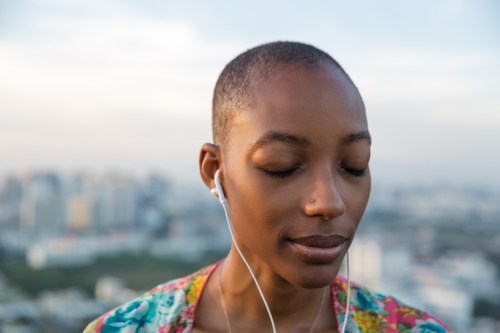Our editors independently select these products. Making a purchase through our links may earn Well+Good a commission
Calm versus Headspace: The 3 best ways to use each leading meditation app
Calm and Headspace are the two biggest players in the digital meditation space. Here's how to answer the question Calm versus Headspace for yourself.

A few years back, a close friend gifted me Yumi Sakugawa’s There Is No Right Way to Meditate: a doodle-filled love letter to meditation that’s basically a mindfulness picture book. As much as I love what’s inside its pages, the book’s title itself has always struck me as the most profound nugget it offers. That is, when it comes to meditation, there’s no single right way to go about it. I’ve taken that notion to heart as I’ve allowed myself to explore methods of mindfulness that don’t necessarily involve sitting on a cushion: Enter, the booming sector of meditation apps, where two specific apps—Calm and Headspace—have pulled ahead of the rest of the pack, as the only two top 10 apps in the Health & Fitness category of the AppStore focused on meditation. And while neither seems to be going anywhere, the question of deciding a winner between Calm versus Headspace is tricky to answer, especially for someone like me who swears by both for different reasons.
Ten years after its 2010 founding, Headspace raised $93 million in new equity in February 2020. And as of February 2019, Calm (founded 2012) raised $88 million dollars. On paper, it would seem that the two are competitors, but it’s hard to classify one as “better” or more useful than the other. Doing so would be decidedly un-Zen, and—in the words of Sakugawa—there’s no right way to meditate. Furthermore, since both apps offer different but still-useful features, perhaps the question shouldn’t be “Calm versus Headspace,” but rather “how to use each app best.” To help you use each app in a way that’s suited for your needs and interests, keep scrolling and learn the best features of each offering.
Calm versus Headspace: which meditation app is *your* path to a clearer mind?
Headspace ($13 per month): For the skeptical, sleepy, and short on time
The mere sound of Headspace founder and narrator, and Well+Good Changemaker Andy Puddicombe’s voice is like a cool, beachside breeze for the mind. That, paired with the app’s brightly hued interface makes it an inviting place to become a student of meditation…all while not taking yourself too seriously. Here are three signs Headspace is right for you:
1. You like to know the “why” behind everything you do
You’ll never dive headfirst into one of Headspace’s meditations without first getting a (sometimes goofy, but always informative) lesson about why a particular practice is useful. If you’re learning visualization meditation, for example, a preliminary video will walk you through a forest lined with red trees and birds to show you what the experience will be like before you actually do it.
2. You want meditate for a specific reason, like making your relationships better
Another standout feature of Headspace is its meditation courses that teach you how to incorporate meditation into situations like prioritizing tasks at work, leaving home for college, grieving the death of a loved one, or handling pressure in sports. In this way, Headspace is able to bring specificity to the very large umbrella we call “stress relief,” and for some, that’s useful.
3. you, like, really, really want to get the whole sleep thing in order
An entire section of the Headspace app dedicates itself to improving your REM cycle. “Sleepcasts” bring slow lit (aka adult storytelling) to your nighttime routine, acts as a white-noise machine, and even comes with “Nightime SOS” feature, which are guided exercises to use when you wake up in the middle of the night.
Calm ($13 per month): For the yoga-loving outdoorsy, spirituality-lover who wants to dive deeper
When you open the Calm app, a serene lake will look back at you as bird-chirping nature music will fill your eardrums. This meditation-retreat vibe runs throughout the app, providing for a more traditionally nature-centric vibe you won’t find on Headspace. Here are three signs Calm is right for you:
1. You don’t love meditating in silence
As mentioned, nature music is a foundation of the Calm app, and it continues even throughout guided meditations. While the app does allow you to control the volume levels depending on your preferences, the ocean and forest soundscapes lend to the overall feeling of the app. This means you have no reason to confront silence in your meditation practice. Rather, get mindful to the sound of crashing waves and wind rustling through the trees.
2. You’re interested in meditation as a way to be a better athlete
LeBron James teaches a five-part class on Calm that’s designed to help you develop a champion’s mind-set. He guides you as you learn to manage emotions, create a pre-game outlook, and harness what every athlete needs the most: good sleep.
3. You want to dabble in ASMR for sleep
In what’s a very unique offering across meditation apps, Calm lets you tap into the power of ASMR for sleep with guided stories narrated by Bob Ross and someone mysteriously named “The French Whisperer.” Like Headspace, Calm offers a wide variety of sleep stories to complement this ASMR practice.
These are the biggest myths about meditation to stop believing now, and here’s how a meditation expert learned to befriend her mind.
Sign up for the Well+Good SHOP Newsletter
Get exclusive deals on wellness, beauty, fitness, and food products that have been hand-picked by our editors.
Got it, you've been added to our email list.









